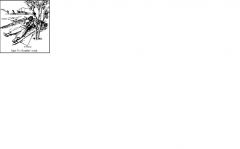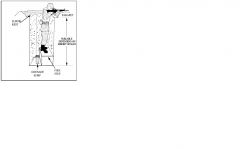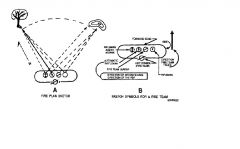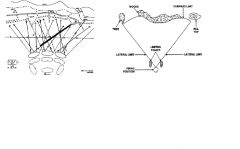![]()
![]()
![]()
Use LEFT and RIGHT arrow keys to navigate between flashcards;
Use UP and DOWN arrow keys to flip the card;
H to show hint;
A reads text to speech;
39 Cards in this Set
- Front
- Back
|
108.1
Standard 782 gear is divided into 3 categories |
1. Fighting load-carrying equipment
2. Bivouac equipment 3. Protective equipment |
|
|
108.1
Standard issue 782 gear items |
- Pistol belt
- Pack combat medium - Suspenders - Two ammo pouches - Canteen cover, canteen, and canteen cup - First-aid packet* - Entrenching tool and cover - Poncho - Shelter half with one tent pole, five tent pins, and guy line - Mess kit with knife, fork and spoon - Bayonet or K-Bar* - Kevlar helmet - Camouflage cover - Hat and mosquito net * These items may or may not be issued. |
|
|
108.2
Hasty / Skirmisher's position |

Shallow pit type of emplacement provides a temporary, open, prone firing position for the individual rifleman.
|
|
|
108.2
Improved one-man fighting position |

It is made as small as possible to present the smallest target to the enemy, but wide enough to accomodate a man's shoulders, and deep enough to use entrenching tools at the bottom.
|
|
|
108.2
Improved two-man fighting position |
Two-man fighting hole consists essentially of two adjacent one-man fighting holes.
|
|
|
108.2
Disadvantages of the two-man fighting hole |
Since it is longer than the one-man type, the two-man fighting hole offers somewhat less protection against a tank crossing along the long axis, as well as less protection against strafing, bombing, and shell fragments
|
|
|
108.2
Advantages of a two-man fighting hole |
It allows continuous observation, mutual assistance and reassurance, and the redistribution of ammunition between the occupants.
|
|
|
108.2
3 ways to dig fighting positions |
a. manual
b. mechanical c. explosives |
|
|
108.4
Actions to be taken if you are caught in the light of a ground flare or overhead flare |
When caught in the open at night with an overhead flare, immediately hit the deck. If you hear the flare fired but it has not burst, hit the ground before it does.
|
|
|
108.5
Discuss the military aspects of terrain as it applies to a defensive force using KOCOA. |
* Key Terrain
* Oberservation and Fields of Fire * Cover * Concealment * Obstacles to Movement * Avenues of Approach |
|
|
108.6
Land Navigation |
Land Navigation requires:
- Map - Compass - Pace Count |
|
|
108.9
Forward Defense Area (FDA) |
Area where frontline defensive positions are dug
|
|
|
108.9
Security Area |
Area in front of FDA Security patrols roams this area. LP / OP is placed here.
|
|
|
108.9
Reserve Area |
Area behind FDA that reserve forces occupy
|
|
|
108.10
Primary Firing Position |
Backbone of the defense, receives the full force of the enemy's attack
|
|
|
108.10
Alternate Firing Position |
Fallback position used if the primary position is in danger of being overrun. Same sector of fire as the primary.
|
|
|
108.10
Supplementary Firing Position |

Sector of fire covers the flank or rear
|
|
|
108.11
Sector of Fire |

- Two stakes are placed near the firing position to indicate lateral limits during darkness
- Sectors of fire interlock to ensure mutual support by adjacent units |
|
|
108.12
Squad Leader |
PO1 with an M16, but only fires in critical situations. Responsible for the training, appearance, discipline and readiness of the squad. Controls fire discipline, fire control, and manuevering.
|
|
|
108.12
Grenadier |
PO3 armed with an M203. Responsible for the employment and care of the 203. Remains close to teh squad leader in combat.
|
|
|
108.12
Fire Team Leader |
PO2 with an M16, but only fires in critical situations. Leads and controls fire team. Acts as the assistant squad leader.
|
|
|
108.12
Automatic Rifleman |
PO3 with a fully auto M16. Backbone of the fire team, providing heavy fire power. Acts as the assistant fire team leader.
|
|
|
108.12
Rifleman number 1 |
SN with an M16 whose primary duty is to carry extra ammo for the automatic rifleman. Protects flank and acts as a scout. Takes control of the automatic rifle if automatic rifleman becomes a casualty.
|
|
|
108.12
Rifleman number 2 |
SN or SA with an M16. Acts as point man and occasionally a scout. Protects the flank of the fire team.
|
|
|
108.13
CODE OF CONDUCT ARTICLE I |
"I am an American, fighting in the armed forces which guard my country and our way of life. I am prepared to give my life in their defense."
|
|
|
108.13
CODE OF CONDUCT ARTICLE II |
"I will never surrender of my own free will. If in command, I will never surrender the members of my command while they still have the means to resist."
|
|
|
108.13
CODE OF CONDUCT ARTICLE III |
"If I am captured, I will continue to resist by all means available. I will make every effort to escape and aid others to escape. I will accept neither parole nor special favors from the enemy."
|
|
|
108.13
CODE OF CONDUCT ARTICLE IV |
"If I become a prisoner of war, I will keep faith with my fellow prisoners. I will give no information nor take part in any action which might be harmful to my comrades. If I am senior, I will take command. If not, I will obey the lawful orders of those appointed over me and will back them in every way."
|
|
|
108.13
CODE OF CONDUCT ARTICLE V |
"When questioned, should I become a prisoner of war, I am required to give name, rank, service number, and date of birth. I will evade answering further questions to the utmost of my ability. I will make no oral or written statements disloyal to my country and its allies, or harmful to their cause."
|
|
|
108.13
CODE OF CONDUCT ARTICLE VI |
"I will never forget that I am an American, fighting for freedom, responsible for my actions, and dedicated to the principles which made my country free. I will trust in my God and in the United States of America."
|
|
|
108.14
Describe the procedures for handling detainees / Enemy Prisoner of War (EPW). Remember the 5 S's and T in handling EPWs |
* Search: for weapns and documents
* Secure: ensure escape is impossible * Silence: do not allow EPWs to talk to each other * Segregate: into groups by rank, gender, and status (deserter, civilian, EPW, etc.) * Speed: timely delivery of information obtained from EPWs is essential * Tagging their belongings |
|
|
108.15
FPCON NORMAL |
General global threat
|
|
|
108.15
FPCON ALPHA |
Increased general threat
|
|
|
108.15
FPCON BRAVO |
More predictable threat
|
|
|
108.15
FPCON CHARLIE |
An incident occurs or intelligence is received
|
|
|
108.15
FPCON DELTA |
Terrorist action against a specific location or person is imminent. This FPCON is normally declared as a localized condition.
|
|
|
108.16
ROE |
ROE is determined by commander's guidance.
|
|
|
108.17
Describe circumstance when deadly force would normally be authorized. |
1. Inherent Right of Self-Defense
2. Defense of Others 3. Assets Vital to National Security 4. Inherently Dangerous Property 5. National Critical Infrastructure 6. Serious offenses Against Persons 7. Arrest or Apprehension 8. Escape |
|
|
108.18
Three classes of wire entanglement |
* TACTICAL WIRE - used to hamper enemy aggresion. Placed along the front of the defensive line.
* PROTECTIVE WIRE- Prevents close surprise attacks. Placed around each fighting position at hand grenade range * SUPPLEMENTARY WIRE - placed to conceal the exact line of the tactical wire. |

